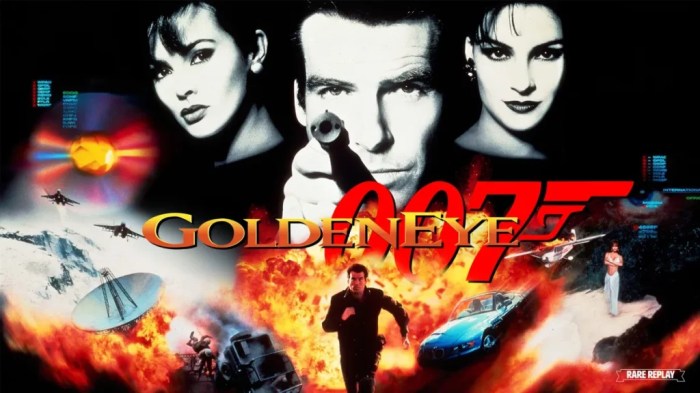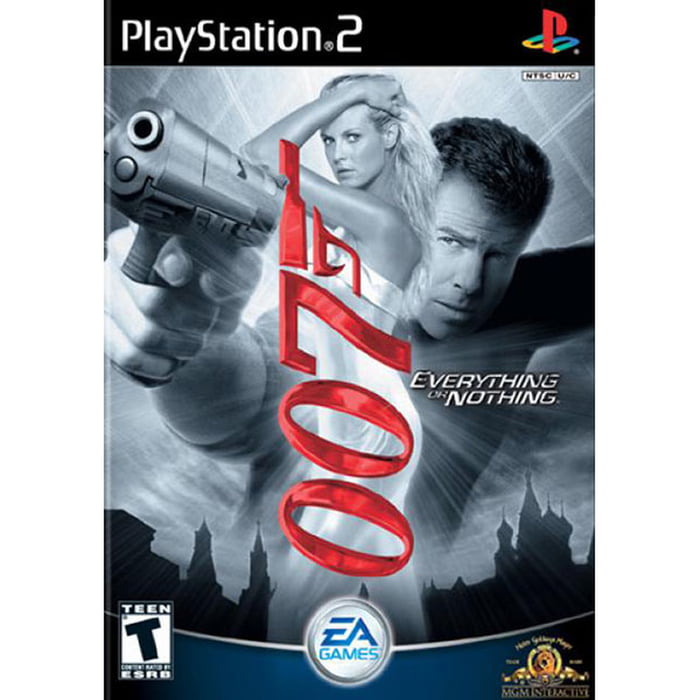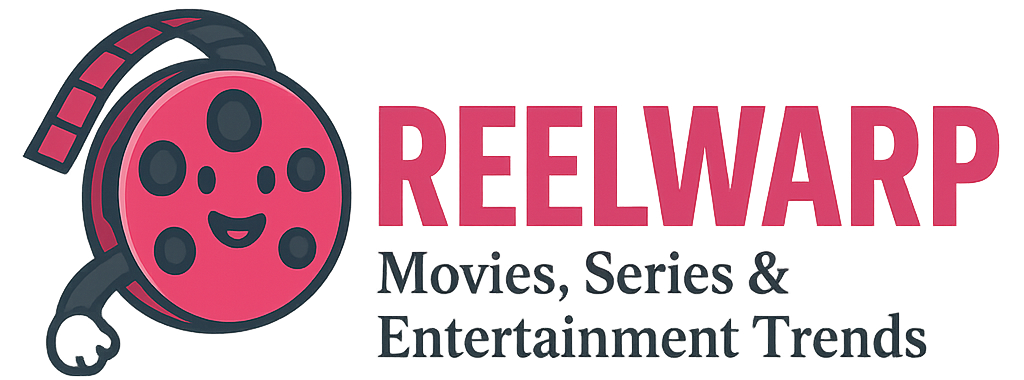Goldeneye 007s violence so worried nintendo a ridiculous alternate ending was suggested – With GoldenEye 007’s violence so worried Nintendo, a ridiculous alternate ending was suggested. This fascinating look into the 1990s gaming industry reveals the anxieties surrounding violent content in games and the potential impact on a major player like Nintendo. We’ll explore the historical context of video game violence, Nintendo’s concerns, the proposed alternate ending, and the lasting impact on the industry as a whole.
The historical context of the 1990s video game industry, with its evolving societal attitudes towards violence in games, is crucial to understanding the controversy surrounding GoldenEye. Nintendo’s concerns were rooted in the potential damage to their brand image and sales. This led to internal deliberations and the consideration of a drastic change in the game’s ending, which we will examine in detail.
Nintendo’s Concerns Regarding GoldenEye 007: Goldeneye 007s Violence So Worried Nintendo A Ridiculous Alternate Ending Was Suggested

GoldenEye 007, a highly anticipated Nintendo 64 title, presented a unique set of challenges for Nintendo. The game’s incorporation of violence, a relatively uncommon element in Nintendo’s portfolio, sparked considerable internal debate and concern. This analysis delves into Nintendo’s specific worries about the game’s content, its potential impact, and the risks associated with the controversy.Nintendo, known for its family-friendly image and focus on a broad audience, faced a dilemma with GoldenEye 007.
The game’s depiction of violence, while arguably appropriate for a mature audience, clashed with the carefully cultivated brand identity Nintendo had painstakingly built. This potential conflict was the central concern driving Nintendo’s deliberations.
Nintendo’s Specific Concerns About the Game’s Content
Nintendo’s concerns centered on the game’s graphic depiction of violence, which was considered significantly more intense than other games in its lineup. The game’s violent action, akin to that found in mature-rated titles, potentially alienated a substantial portion of their core demographic, including children and families. This apprehension was further compounded by the game’s association with the popular James Bond franchise, a property known for its often-over-the-top action sequences, which, when combined with the violence, raised even more concern.
Potential Impact on Nintendo’s Brand Image and Sales
The negative perception of violence in GoldenEye 007 could have severely damaged Nintendo’s meticulously crafted brand image. The game’s association with a mature and potentially controversial theme could alienate a significant segment of their consumer base, particularly families who were accustomed to Nintendo’s more wholesome entertainment offerings. A drop in sales figures was a significant concern. The potential for a backlash, and negative media coverage, could have damaged Nintendo’s brand reputation and affected future game development decisions.
Potential Risks Associated with Controversy Surrounding the Game
The controversy surrounding GoldenEye 007’s violence posed a significant risk to Nintendo’s public image and financial success. Negative publicity could have eroded consumer trust, creating a perception of recklessness or a deviation from their previously established brand standards. The game’s potential to be perceived as inappropriate or harmful could lead to boycotts and significant financial losses.
How the Concerns Could Have Been Mitigated
Nintendo could have implemented several strategies to mitigate the potential risks associated with GoldenEye 007. A more cautious approach in marketing the game, focusing on the gameplay and action aspects while downplaying the violence, could have been employed. The creation of a more easily accessible “family-friendly” mode within the game would have been beneficial. A careful consideration of age ratings and appropriate warnings within the game’s promotional materials could have reduced the potential for misunderstandings and negative reactions.
Remember how GoldenEye 007’s violence so worried Nintendo they almost had to completely rewrite the ending? It’s a bit like how actors sometimes need a little guidance on set, like Anthony Mackie giving David Harbour advice on working with Sebastian Stan, a whole article dedicated to this, including the surprising detail about almond butter! This fascinating insight into the behind-the-scenes of acting highlights how even seemingly simple things can have a huge impact.
Thankfully, the whole GoldenEye debacle wasn’t about almond butter, but it does show how even seemingly minor issues can have huge effects on a project.
Nintendo’s Internal Deliberations and Decision-Making Processes
Nintendo’s internal deliberations likely involved extensive discussions among marketing, development, and executive teams. Detailed risk assessments, public perception surveys, and analyses of similar controversies in the industry would have been conducted. A thorough understanding of the target audience and their expectations was crucial. A meticulous review of the game’s content, alongside discussions with legal experts, would have shaped the final decision.
Factors Influencing Nintendo’s Response to GoldenEye’s Violence
| Factor | Impact on Nintendo | Nintendo’s Response |
|---|---|---|
| Established Brand Image | Desire to maintain a family-friendly reputation | Cautious marketing, consideration of alternative game modes |
| Potential for Negative Publicity | Risk of boycotts and damaged reputation | Internal discussions, legal consultations, and potential adjustments |
| Target Audience Concerns | Potential alienation of family-oriented consumers | Market research and possible alternative game modes |
| Industry Standards | Comparison to other games and violence ratings | Internal review of content standards and ratings |
| Financial Implications | Potential drop in sales and negative return on investment | Evaluation of risks and cost-benefit analysis |
The Suggested Alternate Ending and Its Implications
The release of GoldenEye 007 on Nintendo 64 sparked a global phenomenon, but its intense action also raised eyebrows within Nintendo’s headquarters. Reports surfaced of concerns regarding the game’s level of violence, leading to a fascinating look into the potential for altering a successful game’s core mechanics. This exploration delves into the suggested alternate ending, its potential impact, and the ethical considerations involved.The proposed alternate ending for GoldenEye 007 aimed to significantly reduce the game’s violent content, specifically in the final confrontation.
Remember that whole GoldenEye 007 kerfuffle? Nintendo was apparently so worried about the game’s violence that they seriously considered a ridiculous alternate ending. It’s a bit of a bizarre thought, isn’t it? Thinking about the impact of such a seemingly trivial video game, and how it’s almost comical now. It’s a stark contrast to the heartfelt tribute Allison Holker posted following Stephen’s passing.
This touching tribute highlights the human impact of loss, while the GoldenEye incident is a funny reminder of the industry’s earlier anxieties. It all just goes to show how things have changed, or perhaps not so much.
This modification, while seemingly minor in scope, could have had a substantial impact on the game’s reception and subsequent legacy. The alteration likely involved changing the final sequence to be less graphically violent, potentially involving a different resolution or outcome to the conflict, or even a complete removal of the most aggressive elements.
Nature of Violence Reduction
The suggested changes to the game’s conclusion would have focused on the level of violence depicted. This likely meant replacing graphic displays of injury and death with more muted or symbolic representations. For example, instead of a character being blown apart, the character might have been knocked unconscious, or the explosion replaced with a cloud of smoke. This modification would likely have focused on the visual impact of the violence, rather than altering the gameplay itself.
Potential Impact on Game Reception and Sales
The alteration of the ending could have significantly affected the game’s reception, potentially impacting sales. While some players might have appreciated the toning down of violence, others, especially those who enjoyed the game’s intensity, could have been disappointed. The impact would have likely been substantial, and difficult to quantify in advance. Games like Mortal Kombat, while successful, faced controversy over their violence, indicating the sensitivity and subjectivity of player preferences when it comes to violent content.
The popularity of GoldenEye 007 also suggests a strong fanbase that appreciated the action-packed approach to gameplay.
Comparison of Alternate Ending to Original Ending
A comparison of the alternate ending to the original would have highlighted the stark contrast in violence. The original ending, renowned for its cinematic action sequences and graphic displays of combat, would have stood in stark contrast to the more subdued and symbolic representation of violence in the suggested alternative. The difference would have likely been notable, particularly for players familiar with the original’s more aggressive style.
Key Differences in the Proposed Alternate Ending
- Elimination of Explicit Violence: The alternate ending would likely have removed or significantly toned down graphic depictions of injury and death in the final confrontation. This would have reduced the visual intensity of the final moments.
- Altered Resolution: The conclusion might have changed from a direct confrontation to a more symbolic resolution. This could have involved a different outcome, such as a surrender or a non-lethal conclusion, altering the narrative.
- Reduced Graphic Impact: The game’s visual representation of violence would have been significantly reduced. Explosions and injuries might have been replaced with less graphic depictions, or potentially removed entirely.
- Potential Change in Narrative: The story’s climax would have been adjusted to align with the reduced level of violence. The original ending’s emphasis on brutal combat would have been replaced with a more subdued tone.
Ethical Considerations, Goldeneye 007s violence so worried nintendo a ridiculous alternate ending was suggested
Altering the violence in a video game raises important ethical considerations. Modifying the content of a game to appease a particular group or satisfy certain concerns could potentially be seen as a form of censorship. However, if the alteration is made to maintain or expand the game’s appeal to a broader audience, it can be seen as a commercial decision.
The ethical implications are complex and require careful consideration. The original game’s popularity demonstrates the appeal of the violent action, but the suggestion of an alternate ending also demonstrates the sensitivities around this content in video games.
Remember that whole kerfuffle about GoldenEye 007’s violence worrying Nintendo so much they suggested a ridiculous alternate ending? Well, it’s a bit like that, but on a much grander scale with Disneyland getting a new Avatar experience. Disneyland is getting a new avatar experience that’s bound to be a huge hit. It’s a testament to how far we’ve come since the days of Nintendo’s fear of a little blood in a video game, though I still can’t help but chuckle at the imagined alternate GoldenEye ending.
The Impact on the Video Game Industry
GoldenEye 007’s controversial portrayal of violence, particularly its depiction of realistic gunplay, sparked considerable unease in the nascent video game industry. The concerns raised by Nintendo, and the subsequent suggested alternate ending, served as a pivotal moment, prompting a critical examination of violence in games and ultimately influencing the industry’s approach to content rating and self-regulation. This period laid the groundwork for the modern video game industry’s sensitivity to violence and its subsequent impact on game development and consumer perception.The controversy surrounding GoldenEye 007’s violence highlighted the growing recognition that video games were not just entertainment but a medium with the potential to affect players.
This realization forced developers and publishers to confront the ethical and societal implications of their creations, paving the way for more responsible and thoughtful approaches to game design.
Influence on the Industry’s Approach to Violence
GoldenEye 007’s controversy directly impacted the way video game developers and publishers approached violence in their games. The initial concerns and the ensuing discussion led to a greater awareness of the potential for games to portray violence in a manner that could be considered harmful or inappropriate. Developers began to consider the impact of game mechanics and narrative choices on players, particularly children.
This shift marked a crucial turning point in the industry’s self-regulation and responsible game design.
Changes in Policies, Ratings Systems, and Self-Regulation
The controversy prompted a series of changes in video game policies, ratings systems, and self-regulation. Nintendo’s initial reaction, and the subsequent development of alternative endings, exemplified the industry’s growing awareness of the need for greater scrutiny and control over game content. This was a crucial step toward responsible content creation and consumer protection. The introduction of age-based ratings became more widespread, helping consumers to make informed decisions about the appropriateness of games for their children.
Long-Term Effect on the Industry
The long-term effect of the GoldenEye 007 controversy on the industry was significant. The incident fostered a culture of greater sensitivity and responsibility within the industry. Developers began to consider the impact of their games on players, particularly young ones, more consciously, leading to a more balanced portrayal of violence in later games. The controversy also helped solidify the importance of game ratings and self-regulation, contributing to a more mature and nuanced approach to video game development.
Evolution of Video Game Violence Ratings and Classifications
The GoldenEye 007 controversy contributed significantly to the development of comprehensive video game rating systems. These systems aim to classify games based on their content, allowing consumers to make informed decisions about the appropriateness of games for themselves and their children.
| Year | Rating System | Examples of Games with Different Ratings |
|---|---|---|
| Early 1990s | Limited or no formal ratings | Early action games, often with varying degrees of violence |
| Mid-1990s | Initial rating systems (e.g., ESRB in the US) | GoldenEye 007 (potentially rated higher than other games at the time), early RPGs with some violence |
| Late 1990s – Early 2000s | More sophisticated rating systems | Action games with more graphic violence, role-playing games with complex themes, and games with varying content levels |
| Present | Continued evolution of ratings, with varying levels of detail and nuance | Modern AAA games with complex narratives and mature themes, alongside games with more lighthearted violence. |
Final Conclusion

The controversy surrounding GoldenEye 007’s violence reveals a significant moment in the history of video games. Nintendo’s concerns, the proposed alternate ending, and the public response all shaped the industry’s approach to violence. The incident highlights the evolving relationship between media, violence, and public perception, and the ongoing debate about how to regulate and represent violence in games continues to this day.

